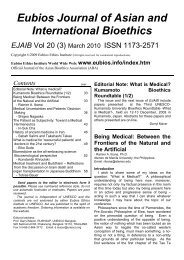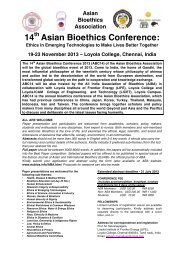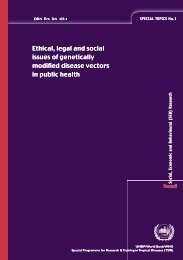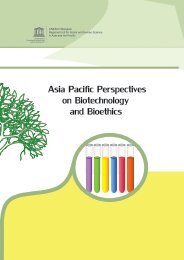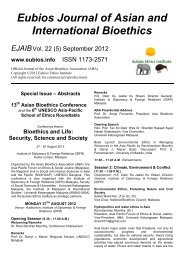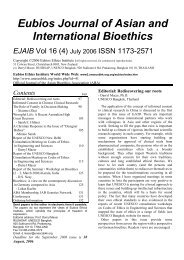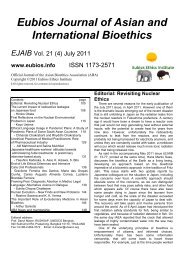Eubios Journal of Asian and International Bioethics - Eubios Ethics ...
Eubios Journal of Asian and International Bioethics - Eubios Ethics ...
Eubios Journal of Asian and International Bioethics - Eubios Ethics ...
Create successful ePaper yourself
Turn your PDF publications into a flip-book with our unique Google optimized e-Paper software.
14 <strong>Eubios</strong> <strong>Journal</strong> <strong>of</strong> <strong>Asian</strong> <strong>and</strong> <strong>International</strong> <strong>Bioethics</strong> 22 (January 2012)<br />
the same year a healthy boy was born in Italy as the<br />
result <strong>of</strong> in vitro fertilization <strong>and</strong> embryo transfer on a<br />
healthy ovum resulting from comprehensive oocyte<br />
screening using array CGH. The task force that was<br />
involved in this pilot study consisted <strong>of</strong> ESHRE president<br />
Luca Gianaroli <strong>and</strong> Dr. Christina Magli <strong>of</strong> the Italian<br />
Society <strong>of</strong> Reproductive Medicine (SISMER) in Bologna,<br />
Bonn University’s Dr. Markus Montag <strong>and</strong> Pr<strong>of</strong>. Hans van<br />
der Ven, with the analysis results <strong>of</strong> their pilot study<br />
presented at the ESHRE 2010 annual general meeting in<br />
Rome. The study reported that “the average age <strong>of</strong><br />
participating patients in the clinical test study was 40” <strong>and</strong><br />
claimed that “the method was useful for women over 37<br />
<strong>and</strong> for those who had suffered from repeated<br />
miscarriage”.<br />
This PGD method <strong>of</strong> polar body analysis does not<br />
require embryo biopsy essential in common PGD, it is a<br />
non-invasive method for the non-inseminated egg cells<br />
that are to be diagnosed, <strong>and</strong> it is an effective method for<br />
increasing pregnancy rates in women <strong>of</strong> advanced age<br />
with an elevated occurrence rate <strong>of</strong> ovum chromosomal<br />
disorders. For this reason, the Reproductive Genetics<br />
Institute 13 in Chicago, USA, reports a high number <strong>of</strong><br />
cases in which polar body analysis PGD has been<br />
performed. Naturally, with polar body analysis PGD, only<br />
the genetic information <strong>of</strong> the mother can be obtained.<br />
5. Is polar body analysis PGD the selection <strong>of</strong> life?<br />
The problem arises as to whether or not the JSOG<br />
non-endorsed polar body analysis PGD as a precaution<br />
against “miscarriage thought to be caused by numerical<br />
chromosomal disorders” is in fact the selection <strong>of</strong> life. In<br />
actuality, a JSOG report concerning the appropriateness<br />
<strong>of</strong> polar body analysis PGD as a precaution against<br />
“miscarriage thought to be caused by numerical<br />
chromosomal disorders” does not currently exist.<br />
Well, would it be possible to utilize polar body analysis<br />
PGD in order to avoid the ethical critique <strong>of</strong> selection <strong>of</strong><br />
life accompanying the common PGD method requiring<br />
embryo biopsy by FISH <strong>and</strong> CGH?<br />
No. And the reason for this answer is that, whether it is<br />
the common PGD method using FISH or CGH, or polar<br />
body analysis PGD using CGH, eventually an<br />
inseminated egg cell has to be chosen. For example, in<br />
the German speaking countries where the beginning <strong>of</strong><br />
life is perceived at the moment <strong>of</strong> insemination, in order<br />
to increase the accuracy <strong>of</strong> the examination, both the<br />
primary polar body excreted by an oocyte prior to<br />
insemination (formed during the primary meiotic division<br />
process <strong>of</strong> the primary oocyte) <strong>and</strong> the secondary polar<br />
body excreted after insemination (formed during the<br />
secondary meiotic division process <strong>of</strong> the secondary<br />
oocyte) are normally used in the diagnosis, despite the<br />
fact that polar body analysis PGD is implemented in<br />
order to avoid the ethical criticism <strong>of</strong> the selection <strong>of</strong> life<br />
accompanying the common PGD method requiring<br />
embryo biopsy. At the moment a secondary polar body<br />
excreted after insemination is used, polar body analysis<br />
13 Kuliev A, Cieslak et al: Chromosomal abnormalities in a<br />
series <strong>of</strong> 6,733 human oocytes in preimplantation diagnosis for<br />
age-related aneuploidies. Reproductive BioMedicine Online<br />
6(11): 54-59, 2003.<br />
PGD is converted from non-inseminated egg cell<br />
diagnosis into inseminated egg cell diagnosis.<br />
In short, polar body analysis PGD not requiring embryo<br />
biopsy is ethical in the sense that it does not entail<br />
inseminated egg cell collection, but, in the sense that<br />
eventually inseminated egg cells are selected, its ethical<br />
evaluation does not differ much from common PGD.<br />
However, as previously stated, even in the natural<br />
circumstances <strong>of</strong> the womb, the selection <strong>of</strong> life occurs.<br />
Concretely speaking, chromosomal disorders (structural<br />
<strong>and</strong> numerical) frequently occur with inseminated egg<br />
cells under natural circumstances. Consequently,<br />
inseminated egg cells with chromosomal disorders, either<br />
do not become implanted in the uterus, or abort even<br />
when they do become implanted. There are cases in<br />
which this natural screening process is sidestepped <strong>and</strong><br />
pregnancy occurs, but the number <strong>of</strong> such cases is<br />
extremely small.<br />
Based on the above facts we can conclude that, the<br />
current JSOG non-endorsed polar body analysis PGD<br />
aimed at preventing “miscarriage thought to be caused<br />
by numerical chromosomal disorders” is a selective relief<br />
action for the precious few inseminated egg cells that are<br />
able to be saved <strong>and</strong> should not be considered the<br />
selection <strong>of</strong> life, as with the JSOG endorsed embryo<br />
biopsy PGD used for patients suffering from “habitual<br />
miscarriage (including recurrent miscarriage) thought to<br />
be caused by structural chromosomal disorders”.<br />
Now, why is so much attention paid to CGH as a<br />
substitute for FISH? This is because CGH 14 makes it<br />
possible for all chromosomes to be very accurately<br />
examined, whereas FISH only allows us to examine the<br />
twelve chromosomes 8, 13, 14, 15, 16, 17, 18, 20, 21,<br />
22, X <strong>and</strong> Y. It is not due to any ethical reasons.<br />
Incidentally, in the German speaking countries where<br />
collecting inseminated egg cells has been prohibited,<br />
polar body analysis PGD by FISH, PCR <strong>and</strong> CGH has a<br />
history <strong>of</strong> being implemented for ethical reasons. The<br />
polar body analysis PGD by CGH notwithst<strong>and</strong>ing,<br />
compared to blastocyst (inseminated egg cells) embryo<br />
biopsy PGD by CGH, the accuracy level <strong>of</strong> analysis using<br />
CGH is considerably lower. In Germany, however, where<br />
people involved in reproductive medicine are greatly<br />
troubled by the low diagnostic accuracy level <strong>of</strong> polar<br />
body analysis PGD, that appeared on the scene as a<br />
substitute for embryo biopsy PGD, in 2010 the supreme<br />
court ruled (dated 6 July 2010) that embryo biopsy PGD<br />
was not illegal. Consequentially, the German<br />
reproductive medicine community, with PGD by polar<br />
body analysis as its mainstream, will draw attention in<br />
order to see if they will, in future, advance towards the<br />
endorsement <strong>of</strong> PGD by embryo biopsy.<br />
14 Progress is also being made towards the possibility <strong>of</strong><br />
implementing array CGH in searching for numerical disorder in<br />
all chromosomes by means <strong>of</strong> genetic chips. ( Wells D,<br />
Alfalawati S, Fragouli E: Use <strong>of</strong> comprehensive chromosomal<br />
screening for embryo assessment: microarrays <strong>and</strong> CGH. Mol<br />
Hum Reprod 14: 703-710, 2008.)



